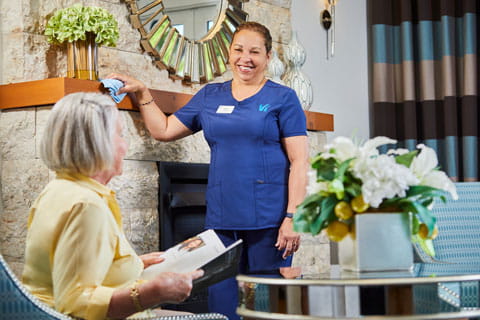For many people, the risk of social isolation and loneliness tends to increase as the years go by. Loneliness and isolation correlate with poor physical and mental health, according to a study by the National Social Life, Health, and Aging Project.
But on the flip side, a 2011 Gallup survey found that participants 65 and older who engaged in daily social activity reported higher levels of enjoyment and happiness.
Maintaining strong social ties as you age is crucial — and a CCRC has built-in opportunities to create and maintain relationships.

There are plenty of opportunities to engage with fellow residents on a daily basis. CCRCs provide residents with built-in access to a robust and stable social network, separate but complementary to residents’ other group memberships and affiliations.

Lifestyle activities
From fitness classes to book club, CCRCs offer robust activities calendars with plenty of opportunities to explore your interests. Whether you’re choosing an activity you already love or trying something new, each activity is an opportunity to connect you to like-minded peers who enjoy the same things you do.

Familiar faces everywhere
In addition to fellow residents, CCRCs are also staffed with dedicated employees — from housekeeping staff to lifestyle coordinators — who get to know residents and greet them like friends and family.
Inclusive (Type A) CCRCs offer seniors a more predictable financial landscape, as the cost of future care is covered by your entrance fee and monthly fees. The monthly fee in a Type A community doesn’t change as you move between independent living and assisted living, skilled nursing, or memory care. Should you need a higher level of care, you’ll see little to no increase in your monthly fee. (The monthly fee does increase slightly over time to account for cost of living, staff raises, and more.)
Other types of CCRC contracts come with less financial predictability because access to care will be provided at market rates.

CCRCs may offer a variety of return options, which allow residents to receive a refund of up to 90% of their entrance fee to themselves or their estate, should they leave the community for any reason.
When considering the potential financial benefits of a CCRC over other senior living models, prospective residents, with the assistance of their financial planners or wealth advisors, might consider residency at a Type A CCRC to be a long-term investment, a mode for asset preservation, and even an important aspect of their trust, estate and generational wealth planning goals.
You may also be able to deduct the nonrefundable portion of your entrance fee on your taxes — but because every senior’s financial situation is different, you should ask your tax professional for more insight.
One of the biggest benefits to a CCRC, of course, is access to a continuum of care on a single campus:
- Independent living
- Assisted living
- Skilled nursing
- Memory support
- Rehabilitation therapy (for an additional fee)
Inclusive (Type A) CCRCs allow residents to move in while they’re independent, with medical and age qualifications in place — but access to each level of care is included with little to no increase in monthly fees. Type B and Type C CCRCs may also offer the security of on-site care with different payment structures.
If the need for care arises, it’s available around the clock from licensed and certified caregivers who have been thoroughly vetted.
Many CCRCs also offer specific programming dedicated to a more holistic idea of health or wellness.
In Vi communities, for example, whole-person wellness is a key part of community life for all residents.
Vi strives to bring wellness to all ages and at every level of care, and our commitment to Living Well brings together wellness for the body, mind, and spirit — not only through health care, but also through fulfilling activities, healthy food options, and more.

Many seniors believe aging in place at home is the gold standard for happiness in retirement. In fact, according to a 2018 AARP study, 76 percent of Americans 50 and older would prefer to stay in their current home.
And that makes sense: Staying in your current home lets you enjoy the aspects of life you’re accustomed to, stick to your routine, and easily keep up with your nearby friends and family.
However, as noted above, many seniors experience loneliness and isolation as they age. It can be increasingly difficult to get out and about to see friends and enjoy the activities you once did.
Aging in place at home can also come with big expenses, including updating your home to be more accessible. And even without those updates, you’ll still have to think about the ongoing maintenance of your home.
Finally, if you need more extensive care down the line, those who remain at home will not only have to source an in-home caregiver or standalone facility themselves, but will also have to pay the current market rate for care services.
Rental communities
The most obvious benefit to a rental community is its low entry cost compared to CCRCs. To move in, residents must only sign a lease and pay a security deposit or community fee.
Rental properties offer similar social connectivity and community benefits to traditional CCRCs. What they don’t provide is guaranteed access to future care.
Rental communities may have relationships with third-party care facilities, or residents may be granted access to on-site care, but rental properties are not required to provide care services, nor are those services included in the cost. If you require assisted living, skilled nursing, or memory support during your time in a rental community, you may be able to bring some of those services to you, but others will require a move to another facility. Either way, you’ll pay the current market rate for those services.
So if you need to make a quick move into another care facility, it may not only be disruptive to your life, but the move will also come with the uncertainty of paying market rates for whatever care services you require.
Are CCRCs right for you?
For many seniors, the benefits of life in a Continuing Care Retirement Community are well worth the investment. And for some, simply having a plan in place for future care is enough to feel secure in their decision!
If you’re thinking about moving into a CCRC, there’s a lot to consider. We have more free resources on our website to help you make the best decision for the next phase of your retirement — check out our Senior Living Guide to start. Plus, our team is always on hand to answer your questions as you consider a move, whether it’s to one of our 10 communities or elsewhere.
Glad to be connected!
There’s a lot to consider when embarking on the next phase of retirement—and contacting us is a big step. (Well done!)
We’ll be in touch soon to share expert insights and resident perspectives that we hope are helpful, and one of our team members will also be reaching out to answer any questions you may have.
